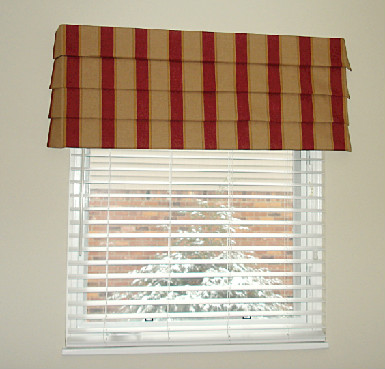
This style called a roman valance because of it’s horizontal pleats emulating a roman shade is the perfect treatment for a striped fabric. You don’t loose the stripes with the horizontal pleats of the roman valance.


|
This style called a roman valance because of it’s horizontal pleats emulating a roman shade is the perfect treatment for a striped fabric. You don’t loose the stripes with the horizontal pleats of the roman valance.
Using battens along your fold lines makes raising your roman shade a pleasure, rather than an annoyance. Stiff battens provide structure. Tunnels are sewn to keep battens from slipping out. A front batten roman shade is characterized by battens, or tunnels, sewn at regular intervals on the front facing side of the shade. A back batten roman shade, as seen in these photographs, is characterized by the battens sewn at regular intervals on the back or lining side of the shade. The clean, dimensional lines of this style work well in all environments. When a stripe or patterned fabric is selected, batten front is a great choice because the battens on the front won’t interfere with the pattern. A flat roman shade with battens adds dimension to the window treatment when the shade is down.
A box pleated valance, creates a softer effect than a cornice. In this room a bright patterned fabric of red and navy was used to compliment the dark walls and the pattern was carefully matched at the pleats. The valance was self-piped along the top edge then attached to a board which was then positioned like a shelf against the wall. Sheer curtains admit natural light into a room, however they have come a long way since they were first used. Today, lightweight, see-through curtains are not only of lace and muslins, but silks and gauze, voiles, cheesecloth and a whole range of synthetic translucents. In this room, a colorful pattern of golds and reds playfully adorn the sheer panels allowing interesting patterns of light to shine through. These panels were mounted on an iron rod and the pleats are held up to the drapery rings to easily open and close.
|
|
by Susan Dorbeck
Dear Susan:
I like the striped valance. If you were to put this on a 3″ rod, would the stiching be underneath the top pleat, so you wouldn’t see it? I need (2) like the above and my window measures 50 1/2″ from casing to casing so that doesn’t include the return on each end. I would like it 18″ OR 20″ long. If I bought the material & sent it to you how much would I need and how much would you charge me to make the 2 valances. Please let me know. Thanks.
Judy Sylvester